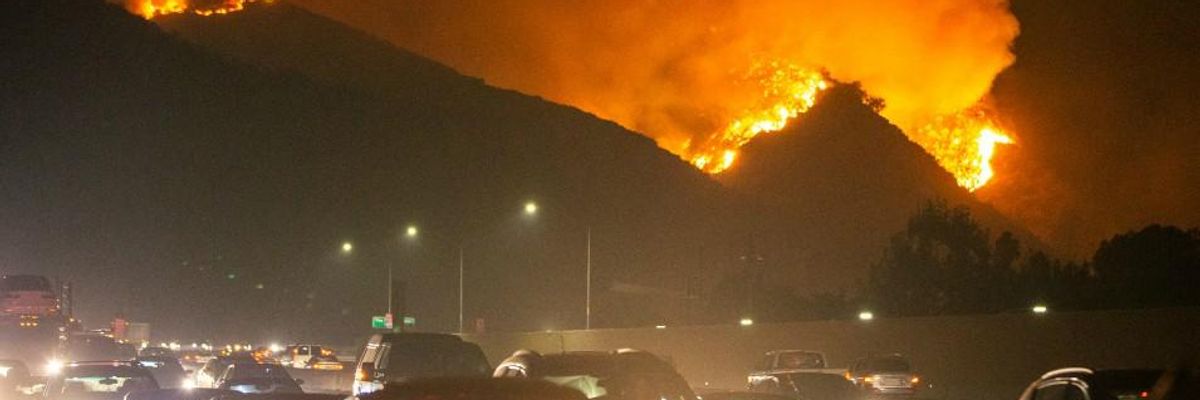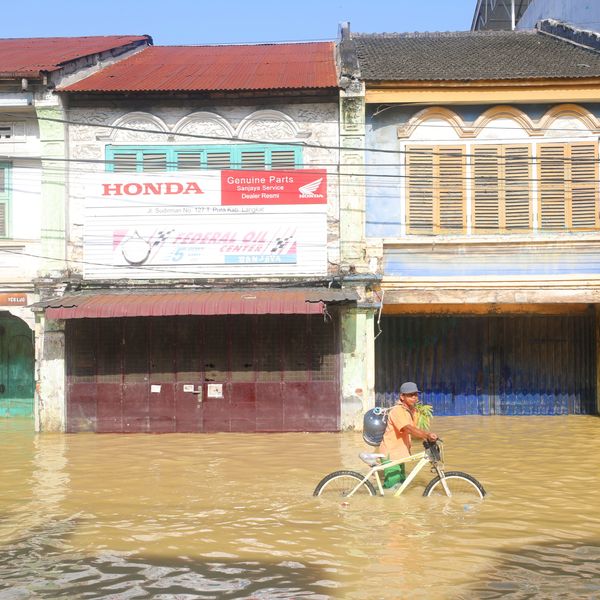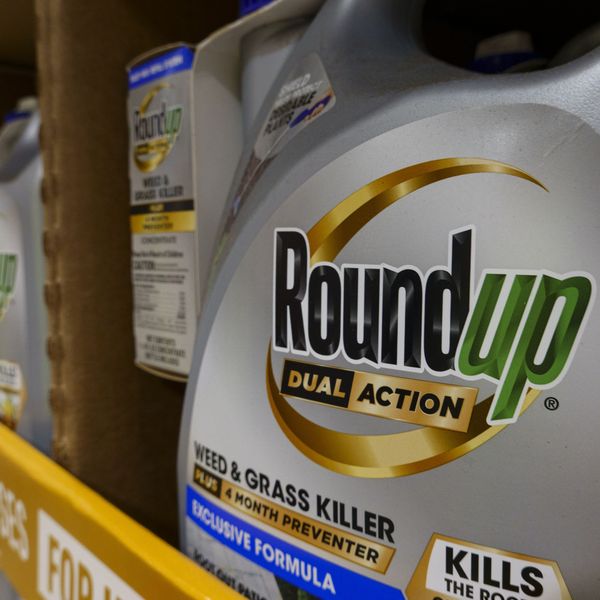
A wildfire is seen near Getty Center in Los Angeles on Oct. 28, 2019. (Photo: Qian Weizhong/Xinhua via Getty)
With 14 'Billion-Dollar Disasters' and Record-Breaking Heat in Alaska and Across South, 2019 Was a Year of Climate Extremes for US
"Americans are put at risk by the serious consequences of the climate crisis."
Underscoring the need for urgent climate action, a new report on the climate of the United States in 2019 sheds light on numerous weather and temperature extremes that were observed throughout the year and the record amounts of money spent on weather disasters.
Alaska was among the states which recorded unusually high temperatures in 2019, according to an annual summary released Wednesday by NOAA ahead of its full U.S. Climate Report, which is scheduled to be released next week.
\u201cNOTE: additional graphic - Alaska had its warmest year on record (2019) per @NOAANCEIclimate https://t.co/xepop9Rmnk #StateOfClimate\u201d— NOAA (@NOAA) 1578505190
The state had its warmest year ever recorded, with a statewide average temperature of 32.2o Fahrenheit--more than 6o above the long-term average temperature. The city of Anchorage had its first 90o day on record.
The year continued a recent trend for Alaska; four of the last six years have been the state's warmest on record.
Record-breaking heat was also recorded last year throughout the Southeast, with both Georgia and North Carolina experiencing their hottest year ever. Florida, South Carolina, and Virginia also had their second-hottest year.
\u201c.@NOAA has released a summary of its 2019 climate data (full report slated for Jan. 14). One clear 10,000-foot takeaway? The Southeast, including parts of Virginia, saw some of its hottest temperatures ever in 2019.\u201d— Sarah Vogelsong (@Sarah Vogelsong) 1578520742
The economic burdens associated with the climate crisis also became apparent in 2019; the cost of repairing damage and supporting communities which suffered extreme weather events reached $45 billion, more than $1 billion over the yearly average.
Almost half of that cost was due to flooding events, three of which cost more than $1 billion.
\u201cThe U.S. experienced 14 #BillionDollarDisasters in 2019: @NOAANCEIclimate https://t.co/xepop9Rmnk #StateOfClimate\u201d— NOAA (@NOAA) 1578505963
In 2019, the U.S. had 14 "billion-dollar disasters," each costing at least $1 billion. In addition to the floods, eight severe storms, two tropical cyclones, and one wildfire topped $1 billion.
According to NOAA, the number of billion-dollar disasters rose drastically over the past decade. Even after adjusting for inflation, the U.S. spent at least $1 billion to repair the damage of 119 disasters in the 2010s, compared with just 59 in the preceding decade.
NOAA's ranking of yearly climate extremes placed 2019 in the top third for the 110-year period the agency has on record. The U.S. Climate Extremes Index was 14% higher than average last year, with warm extremes recorded across the Southeast, cold extremes throughout the Midwest, and precipitation extremes throughout much of the Eastern United States. Overall, 2019 was the second-wettest year on record in the U.S., with scientists recording nearly 35 inches of precipitation--4.84 inches above average.
The agency's report summary garnered the attention of the House Science Committee.
"Americans are put at risk by the serious consequences of the climate crisis," tweeted the committee. "We must work together to address this global threat."
\u201cThe @NOAA 2019 Annual US Climate Report found that 2019 was the 2nd wettest year on record for the US and the hottest year ever recorded for Alaska. Americans are put at risk by the serious consequences of the #ClimateCrisis. We must work together to address this global threat.\u201d— Science Committee (@Science Committee) 1578520959
The full U.S. Climate Report will be released January 14.
An Urgent Message From Our Co-Founder
Dear Common Dreams reader, The U.S. is on a fast track to authoritarianism like nothing I've ever seen. Meanwhile, corporate news outlets are utterly capitulating to Trump, twisting their coverage to avoid drawing his ire while lining up to stuff cash in his pockets. That's why I believe that Common Dreams is doing the best and most consequential reporting that we've ever done. Our small but mighty team is a progressive reporting powerhouse, covering the news every day that the corporate media never will. Our mission has always been simple: To inform. To inspire. And to ignite change for the common good. Now here's the key piece that I want all our readers to understand: None of this would be possible without your financial support. That's not just some fundraising cliche. It's the absolute and literal truth. We don't accept corporate advertising and never will. We don't have a paywall because we don't think people should be blocked from critical news based on their ability to pay. Everything we do is funded by the donations of readers like you. Will you donate now to help power the nonprofit, independent reporting of Common Dreams? Thank you for being a vital member of our community. Together, we can keep independent journalism alive when it’s needed most. - Craig Brown, Co-founder |
Underscoring the need for urgent climate action, a new report on the climate of the United States in 2019 sheds light on numerous weather and temperature extremes that were observed throughout the year and the record amounts of money spent on weather disasters.
Alaska was among the states which recorded unusually high temperatures in 2019, according to an annual summary released Wednesday by NOAA ahead of its full U.S. Climate Report, which is scheduled to be released next week.
\u201cNOTE: additional graphic - Alaska had its warmest year on record (2019) per @NOAANCEIclimate https://t.co/xepop9Rmnk #StateOfClimate\u201d— NOAA (@NOAA) 1578505190
The state had its warmest year ever recorded, with a statewide average temperature of 32.2o Fahrenheit--more than 6o above the long-term average temperature. The city of Anchorage had its first 90o day on record.
The year continued a recent trend for Alaska; four of the last six years have been the state's warmest on record.
Record-breaking heat was also recorded last year throughout the Southeast, with both Georgia and North Carolina experiencing their hottest year ever. Florida, South Carolina, and Virginia also had their second-hottest year.
\u201c.@NOAA has released a summary of its 2019 climate data (full report slated for Jan. 14). One clear 10,000-foot takeaway? The Southeast, including parts of Virginia, saw some of its hottest temperatures ever in 2019.\u201d— Sarah Vogelsong (@Sarah Vogelsong) 1578520742
The economic burdens associated with the climate crisis also became apparent in 2019; the cost of repairing damage and supporting communities which suffered extreme weather events reached $45 billion, more than $1 billion over the yearly average.
Almost half of that cost was due to flooding events, three of which cost more than $1 billion.
\u201cThe U.S. experienced 14 #BillionDollarDisasters in 2019: @NOAANCEIclimate https://t.co/xepop9Rmnk #StateOfClimate\u201d— NOAA (@NOAA) 1578505963
In 2019, the U.S. had 14 "billion-dollar disasters," each costing at least $1 billion. In addition to the floods, eight severe storms, two tropical cyclones, and one wildfire topped $1 billion.
According to NOAA, the number of billion-dollar disasters rose drastically over the past decade. Even after adjusting for inflation, the U.S. spent at least $1 billion to repair the damage of 119 disasters in the 2010s, compared with just 59 in the preceding decade.
NOAA's ranking of yearly climate extremes placed 2019 in the top third for the 110-year period the agency has on record. The U.S. Climate Extremes Index was 14% higher than average last year, with warm extremes recorded across the Southeast, cold extremes throughout the Midwest, and precipitation extremes throughout much of the Eastern United States. Overall, 2019 was the second-wettest year on record in the U.S., with scientists recording nearly 35 inches of precipitation--4.84 inches above average.
The agency's report summary garnered the attention of the House Science Committee.
"Americans are put at risk by the serious consequences of the climate crisis," tweeted the committee. "We must work together to address this global threat."
\u201cThe @NOAA 2019 Annual US Climate Report found that 2019 was the 2nd wettest year on record for the US and the hottest year ever recorded for Alaska. Americans are put at risk by the serious consequences of the #ClimateCrisis. We must work together to address this global threat.\u201d— Science Committee (@Science Committee) 1578520959
The full U.S. Climate Report will be released January 14.
Underscoring the need for urgent climate action, a new report on the climate of the United States in 2019 sheds light on numerous weather and temperature extremes that were observed throughout the year and the record amounts of money spent on weather disasters.
Alaska was among the states which recorded unusually high temperatures in 2019, according to an annual summary released Wednesday by NOAA ahead of its full U.S. Climate Report, which is scheduled to be released next week.
\u201cNOTE: additional graphic - Alaska had its warmest year on record (2019) per @NOAANCEIclimate https://t.co/xepop9Rmnk #StateOfClimate\u201d— NOAA (@NOAA) 1578505190
The state had its warmest year ever recorded, with a statewide average temperature of 32.2o Fahrenheit--more than 6o above the long-term average temperature. The city of Anchorage had its first 90o day on record.
The year continued a recent trend for Alaska; four of the last six years have been the state's warmest on record.
Record-breaking heat was also recorded last year throughout the Southeast, with both Georgia and North Carolina experiencing their hottest year ever. Florida, South Carolina, and Virginia also had their second-hottest year.
\u201c.@NOAA has released a summary of its 2019 climate data (full report slated for Jan. 14). One clear 10,000-foot takeaway? The Southeast, including parts of Virginia, saw some of its hottest temperatures ever in 2019.\u201d— Sarah Vogelsong (@Sarah Vogelsong) 1578520742
The economic burdens associated with the climate crisis also became apparent in 2019; the cost of repairing damage and supporting communities which suffered extreme weather events reached $45 billion, more than $1 billion over the yearly average.
Almost half of that cost was due to flooding events, three of which cost more than $1 billion.
\u201cThe U.S. experienced 14 #BillionDollarDisasters in 2019: @NOAANCEIclimate https://t.co/xepop9Rmnk #StateOfClimate\u201d— NOAA (@NOAA) 1578505963
In 2019, the U.S. had 14 "billion-dollar disasters," each costing at least $1 billion. In addition to the floods, eight severe storms, two tropical cyclones, and one wildfire topped $1 billion.
According to NOAA, the number of billion-dollar disasters rose drastically over the past decade. Even after adjusting for inflation, the U.S. spent at least $1 billion to repair the damage of 119 disasters in the 2010s, compared with just 59 in the preceding decade.
NOAA's ranking of yearly climate extremes placed 2019 in the top third for the 110-year period the agency has on record. The U.S. Climate Extremes Index was 14% higher than average last year, with warm extremes recorded across the Southeast, cold extremes throughout the Midwest, and precipitation extremes throughout much of the Eastern United States. Overall, 2019 was the second-wettest year on record in the U.S., with scientists recording nearly 35 inches of precipitation--4.84 inches above average.
The agency's report summary garnered the attention of the House Science Committee.
"Americans are put at risk by the serious consequences of the climate crisis," tweeted the committee. "We must work together to address this global threat."
\u201cThe @NOAA 2019 Annual US Climate Report found that 2019 was the 2nd wettest year on record for the US and the hottest year ever recorded for Alaska. Americans are put at risk by the serious consequences of the #ClimateCrisis. We must work together to address this global threat.\u201d— Science Committee (@Science Committee) 1578520959
The full U.S. Climate Report will be released January 14.

